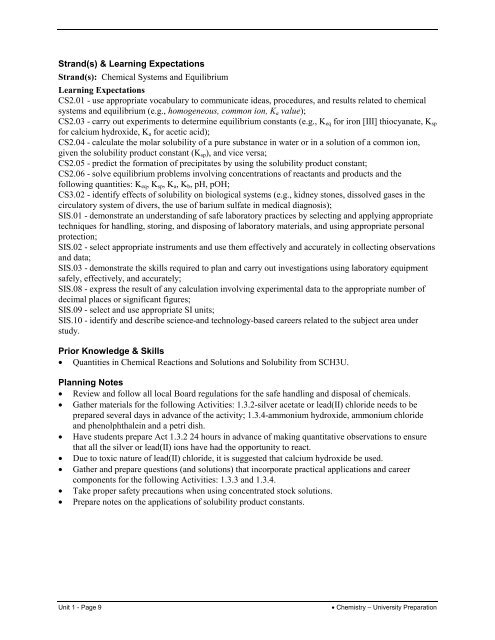Course Profile - Curriculum Services Canada
Course Profile - Curriculum Services Canada
Course Profile - Curriculum Services Canada
You also want an ePaper? Increase the reach of your titles
YUMPU automatically turns print PDFs into web optimized ePapers that Google loves.
Strand(s) & Learning Expectations<br />
Strand(s): Chemical Systems and Equilibrium<br />
Learning Expectations<br />
CS2.01 - use appropriate vocabulary to communicate ideas, procedures, and results related to chemical<br />
systems and equilibrium (e.g., homogeneous, common ion, K a value);<br />
CS2.03 - carry out experiments to determine equilibrium constants (e.g., K eq for iron [III] thiocyanate, K sp<br />
for calcium hydroxide, K a for acetic acid);<br />
CS2.04 - calculate the molar solubility of a pure substance in water or in a solution of a common ion,<br />
given the solubility product constant (K sp ), and vice versa;<br />
CS2.05 - predict the formation of precipitates by using the solubility product constant;<br />
CS2.06 - solve equilibrium problems involving concentrations of reactants and products and the<br />
following quantities: K eq , K sp , K a , K b , pH, pOH;<br />
CS3.02 - identify effects of solubility on biological systems (e.g., kidney stones, dissolved gases in the<br />
circulatory system of divers, the use of barium sulfate in medical diagnosis);<br />
SIS.01 - demonstrate an understanding of safe laboratory practices by selecting and applying appropriate<br />
techniques for handling, storing, and disposing of laboratory materials, and using appropriate personal<br />
protection;<br />
SIS.02 - select appropriate instruments and use them effectively and accurately in collecting observations<br />
and data;<br />
SIS.03 - demonstrate the skills required to plan and carry out investigations using laboratory equipment<br />
safely, effectively, and accurately;<br />
SIS.08 - express the result of any calculation involving experimental data to the appropriate number of<br />
decimal places or significant figures;<br />
SIS.09 - select and use appropriate SI units;<br />
SIS.10 - identify and describe science-and technology-based careers related to the subject area under<br />
study.<br />
Prior Knowledge & Skills<br />
• Quantities in Chemical Reactions and Solutions and Solubility from SCH3U.<br />
Planning Notes<br />
• Review and follow all local Board regulations for the safe handling and disposal of chemicals.<br />
• Gather materials for the following Activities: 1.3.2-silver acetate or lead(II) chloride needs to be<br />
prepared several days in advance of the activity; 1.3.4-ammonium hydroxide, ammonium chloride<br />
and phenolphthalein and a petri dish.<br />
• Have students prepare Act 1.3.2 24 hours in advance of making quantitative observations to ensure<br />
that all the silver or lead(II) ions have had the opportunity to react.<br />
• Due to toxic nature of lead(II) chloride, it is suggested that calcium hydroxide be used.<br />
• Gather and prepare questions (and solutions) that incorporate practical applications and career<br />
components for the following Activities: 1.3.3 and 1.3.4.<br />
• Take proper safety precautions when using concentrated stock solutions.<br />
• Prepare notes on the applications of solubility product constants.<br />
Unit 1 - Page 9<br />
• Chemistry – University Preparation
















